Table of Contents
Ever wanted to make that comforting cup of genmaicha tea at home? It’s not as tricky as you might think. This tea, a mix of green tea leaves and roasted brown rice, has this wonderfully toasty, nutty flavor that’s just perfect for a cozy afternoon. Forget those fancy cafes, we’re going to walk through the genmaicha tea how to brew process at home so you can enjoy it anytime. It’s all about getting a few things right, from the water temperature to how long you let it steep. Let’s get brewing!
Key Takeaways
- Genmaicha is a Japanese green tea blended with roasted brown rice, giving it a unique nutty and toasty flavor.
- The right water temperature is important: boiling water (around 100°C) is good for standard genmaicha to bring out the aroma, while slightly cooler water (around 80°C) is better for high-grade genmaicha to preserve its delicate flavors.
- Steeping time matters; generally 30 seconds for normal grade and 60 seconds for high grade, to avoid bitterness.
- Using quality tea leaves and fresh roasted brown rice makes a big difference in the final taste.
- Experimenting with the ratio of tea leaves to rice can help you find your perfect genmaicha flavor, from more tea-forward to milder and nuttier.
Understanding Genmaicha Tea

What is Genmaicha?
Genmaicha is a Japanese green tea that’s pretty unique. It’s made by mixing roasted brown rice with green tea leaves, usually sencha or bancha. This combination gives it a really distinct flavor profile that’s both comforting and refreshing. You might sometimes hear it called “popcorn tea” because some of the rice grains can puff up and look a bit like popcorn when they’re roasted. It’s a staple in Japanese tea culture and often one of the first Japanese teas people try when they’re exploring beyond their usual cup.
The Popularity of Genmaicha
This tea has been around for ages in Japan, and its popularity has really taken off globally in recent years. It’s known for being a healthy and easy-to-drink beverage that appeals to a wide range of people. Its unique taste and aroma, thanks to that blend of green tea and roasted rice, make it a go-to for many. Whether you need a little pick-me-up in the afternoon or a calming drink in the evening, genmaicha fits the bill. It’s generally more affordable than some other Japanese green teas, making it accessible for everyday enjoyment.
Genmaicha Flavor Profile
So, what does genmaicha actually taste like? Well, it’s a really interesting mix. You get the fresh, sometimes grassy notes from the green tea, balanced out by the nutty, toasty, and slightly sweet flavor of the roasted brown rice. It’s not overly bitter or astringent, which is a big plus for many tea drinkers. The aroma is also a big part of the experience, with that warm, inviting scent of toasted rice.
Here’s a quick rundown of its characteristics:
- Brew Color: Typically a light, golden yellow.
- Base Tea: Usually Sencha or Bancha.
- Flavor Notes: Grassy, nutty, slightly sweet, toasty.
- Aroma: Distinctive roasted rice scent.
The balance between the green tea and the rice is what makes genmaicha so special.
Essential Ingredients and Tools
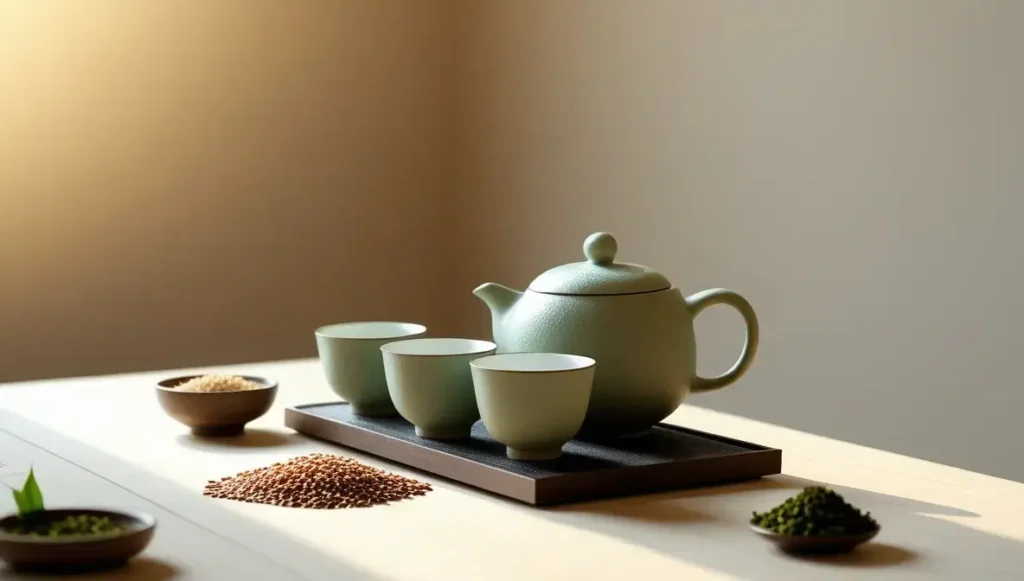
Alright, let’s talk about what you’ll need to get started brewing some seriously good genmaicha at home. It’s not complicated, but paying a little attention to the details here really makes a difference. Think of it like gathering your ingredients before you start cooking – the better the stuff you start with, the better the final dish, or in this case, tea.
Selecting High-Quality Tea Leaves
The foundation of any genmaicha is, of course, the green tea itself. You’ve got options here, but generally, you’ll want to go for something fresh and good quality. Sencha is a really popular choice, and for good reason. It’s got a nice balance that plays well with the rice. Bancha is another option, often a bit more robust. Some folks even use Hojicha, which is already roasted, giving you a double-roast vibe with the rice. The type of green tea you pick will definitely shape the final taste of your genmaicha. If you’re just starting, a good quality Sencha is a safe bet.
Choosing Roasted Brown Rice
This is the other half of the genmaicha equation. You need brown rice that’s been roasted. You can buy it pre-mixed with tea, or you can buy the roasted rice separately to mix yourself. If you’re buying it separately, look for rice that’s been roasted to a nice, light golden brown. It shouldn’t be burnt or too pale. The roasting process brings out this wonderful, nutty, toasty aroma and flavor that’s just so comforting. Freshly roasted rice is key here; stale rice won’t give you that pop.
Recommended Brewing Vessels
While you can technically brew genmaicha in any old teapot and cup, using the right tools can make the experience a bit more authentic and, dare I say, enjoyable. A kyusu, which is a traditional Japanese teapot, is often recommended. They usually have a built-in mesh filter, which is super handy. If you’re brewing for yourself or one other person, a smaller kyusu is fine. If you’re making a bigger batch, a larger one works well. You’ll also want some cups. Traditional Japanese tea cups, called chawan, are lovely, but any small teacup will do the job. The main thing is having a vessel that allows the leaves to unfurl and the flavors to mingle properly.
Here’s a quick rundown of what’s helpful:
- Kyusu (Teapot): Look for one with a fine mesh filter. Size depends on how much you usually brew.
- Tea Cups: Small cups are best for appreciating the aroma and flavor in smaller sips.
- Kettle: For heating your water to the right temperature.
- Measuring Spoons/Scale: For getting the tea-to-water ratio right.
Don’t stress too much about having the fanciest gear right away. The most important things are good quality tea and rice, and a willingness to experiment a little to find what you like best. You can always upgrade your tools later if you get really into it.
👉 Discover the Ultimate Premium Genmaicha Tea Experience Today 👈
Mastering the Brewing Process
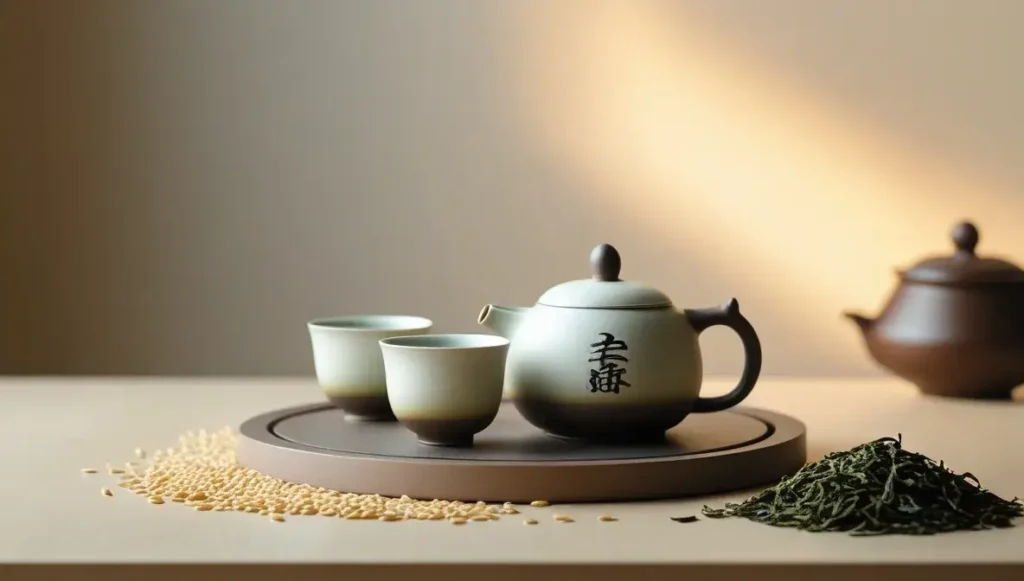
Alright, so you’ve got your fancy Genmaicha and the right gear. Now comes the part where we actually make the tea. It’s not super complicated, but there are a few things to keep in mind to get it just right. Think of it like cooking – a little attention to detail makes a big difference.
Determining the Right Water Temperature
This is a big one, honestly. The temperature of your water can totally change how the tea tastes. For most Genmaicha, especially the everyday kind, you want to go with boiling water. Like, straight off the boil. This really helps to wake up those roasted rice notes and the green tea leaves, giving you that full, warm aroma. But, if you’ve got a fancier, higher-grade Genmaicha, you might want to back off a bit. Using water that’s cooled down to around 80 degrees Celsius (that’s about 175°F) lets you taste more of the tea’s natural sweetness and that subtle umami flavor, without making it too bitter.
Measuring Tea Leaves and Water
Getting the amounts right is pretty straightforward. A good starting point is about 6 grams of Genmaicha for every 200 ml of water. If you don’t have a scale, that’s roughly 3 teaspoons. It sounds like a lot, but remember, it’s a mix of tea leaves and rice. For the water, a neat trick is to pour the water you plan to use into your teacup first. That way, you know exactly how much you need. Just remember the tea leaves will soak up some of that water, so add a little extra to your kettle.
Optimal Steeping Times
Here’s where you don’t want to overdo it. For a standard Genmaicha brewed with boiling water, a quick 30-second steep is usually plenty. Any longer and you risk making it bitter. If you’re using that cooler water for a high-grade tea, you can let it steep a bit longer, maybe around 60 seconds. It’s all about finding that sweet spot where the flavors come out without getting harsh.
Don’t be afraid to experiment a little. These are just guidelines, and your taste buds are the ultimate judge. What tastes perfect to one person might be a bit strong or weak for another. That’s the fun of making tea at home!
Here’s a quick rundown to help you remember:
- Normal Grade Genmaicha: Use boiling water (100°C / 212°F) for about 30 seconds.
- High-Grade Genmaicha: Use water around 80°C (175°F) for about 60 seconds.
Remember, these are starting points. If your first cup isn’t quite right, don’t sweat it. Just tweak the time or temperature next time.
Achieving the Perfect Brew
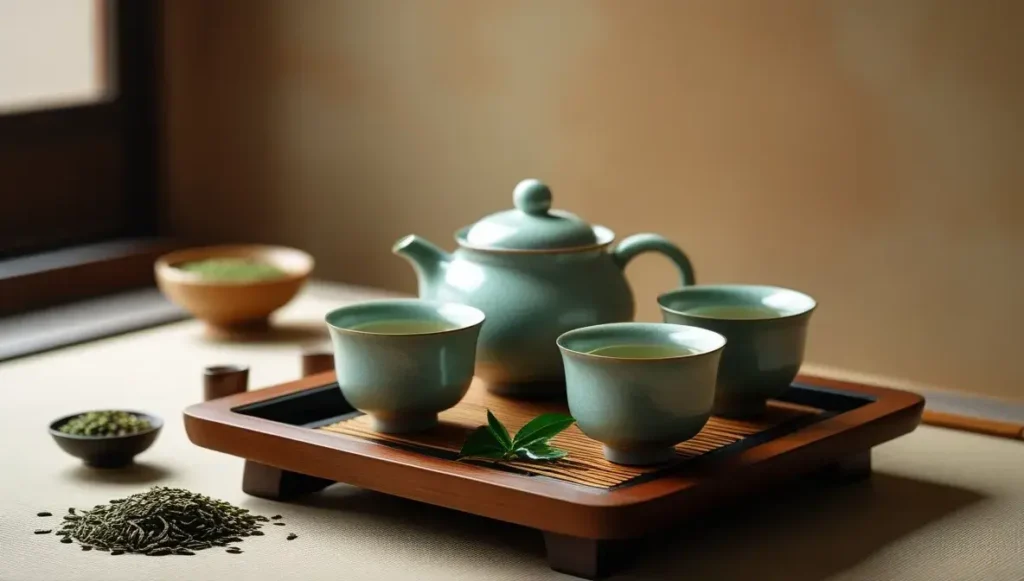
Alright, so you’ve got your genmaicha, your water’s ready, and you’re about to make some tea. It’s not super complicated, but there are a couple of things that make a big difference between a ‘meh’ cup and a ‘wow, that’s good’ cup.
Brewing Normal Grade Genmaicha
For the everyday genmaicha, the kind you probably grab for a casual afternoon cup, you want to go with hot water. Like, really hot. Think boiling, or very close to it. This helps to really wake up those roasted rice bits and get all that nutty aroma out. It’s all about getting that comforting, toasty smell to really pop.
Here’s a quick rundown:
- Water Temperature: Aim for 100°C (212°F). Just bring it to a boil and use it right away.
- Tea Leaves: About 6 grams (roughly 3 teaspoons) per 200 ml of water is a good starting point.
- Steeping Time: Keep it short, around 30 seconds. Any longer and you risk making it a bit bitter, which nobody wants.
Brewing High-Grade Genmaicha
Now, if you’ve splurged on a fancier genmaicha, you’ll want to treat it a little differently. These often have a more delicate green tea base, and you don’t want to scorch it. The goal here is to bring out the subtle sweetness and the umami (that savory, fifth taste) without making it taste too grassy or bitter.
- Water Temperature: Lower it down to about 80°C (176°F). You can do this by letting the boiled water sit for a few minutes or by pouring it into another vessel and back again.
- Tea Leaves: Stick with the same amount, around 6 grams (3 teaspoons) per 200 ml.
- Steeping Time: Give it a bit more time to steep, about 60 seconds. This allows those more complex flavors to unfurl.
Tips for Enhancing Aroma and Flavor
No matter what grade you’re brewing, a few little tricks can make your genmaicha even better. It’s these small adjustments that really make you feel like you’ve got the hang of it.
Pay attention to the pouring. When serving multiple cups, pour a little into each cup, then go back and top them up, alternating between cups. This makes sure everyone gets a cup with the same flavor strength. Don’t leave any tea in the pot after the first pour; get every last drop out. This is super important if you plan on a second infusion.
- Don’t Over-Steep: Seriously, this is the number one way to make green tea bitter. Stick to the times. If you’re unsure, err on the side of shorter.
- Use Good Water: If your tap water tastes funky, your tea probably will too. Filtered or spring water makes a noticeable difference.
- Warm Your Pot: A quick rinse with hot water before you add the leaves and water can help keep the brewing temperature steady.
👉 Upgrade Your Moments with This Breakthrough Genmaicha Creation 👈
Serving and Enjoying Your Genmaicha
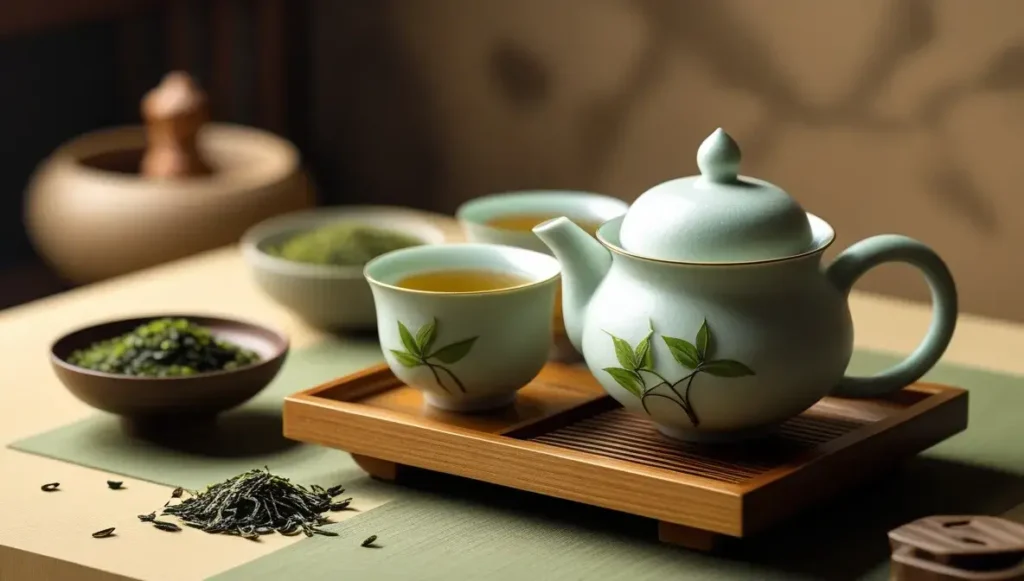
The Art of Pouring
Serving Genmaicha is more than just pouring tea; it’s about ensuring everyone gets a cup that tastes just right. If you’re serving multiple people, you’ll want to make sure the strength of the tea is consistent across all cups. This is where a technique called “Mawashisogi” comes in handy. It involves pouring the tea in a specific pattern to even out the flavor. Start by pouring a little tea into each cup in sequence, then repeat the process, often in reverse order. This way, no one gets a cup that’s too strong or too weak. Pouring until the very last drop is also a good idea, as it helps keep the tea flavorful for the next infusion.
Preparing for a Second Infusion
Don’t toss those leaves after the first pour! Genmaicha is great for a second infusion. For this round, you can often use water that’s a bit hotter than the first. If you used 80°C for a high-grade tea the first time, try around 90°C for the second. The leaves are already open, so the flavor will come out quickly. A very short steeping time, sometimes just seconds, is usually enough. Remember that last drop from the first pour? It really helps make this second infusion just as good.
Savoring the Experience
So, how to enjoy genmaicha? Take a moment to appreciate the aroma. The roasted rice gives it a unique, comforting smell that’s different from other green teas. As you sip, notice the balance between the green tea’s slight bitterness and the rice’s nutty sweetness. It’s a tea that feels both familiar and interesting. It’s perfect for a quiet afternoon or a casual get-together.
Here’s a quick guide to brewing for enjoyment:
- Normal Grade Genmaicha: Use boiling water (around 100°C) for about 30 seconds. This really brings out the roasted rice aroma.
- High-Grade Genmaicha: Use slightly cooler water (around 80°C) for about 60 seconds. This helps bring out the tea’s natural sweetness and umami.
Genmaicha is a tea that invites you to slow down. Its comforting aroma and balanced flavor make it a wonderful choice for moments of relaxation or shared conversation. Don’t rush the process; let the simple goodness of the tea unfold.
Experimenting with Genmaicha
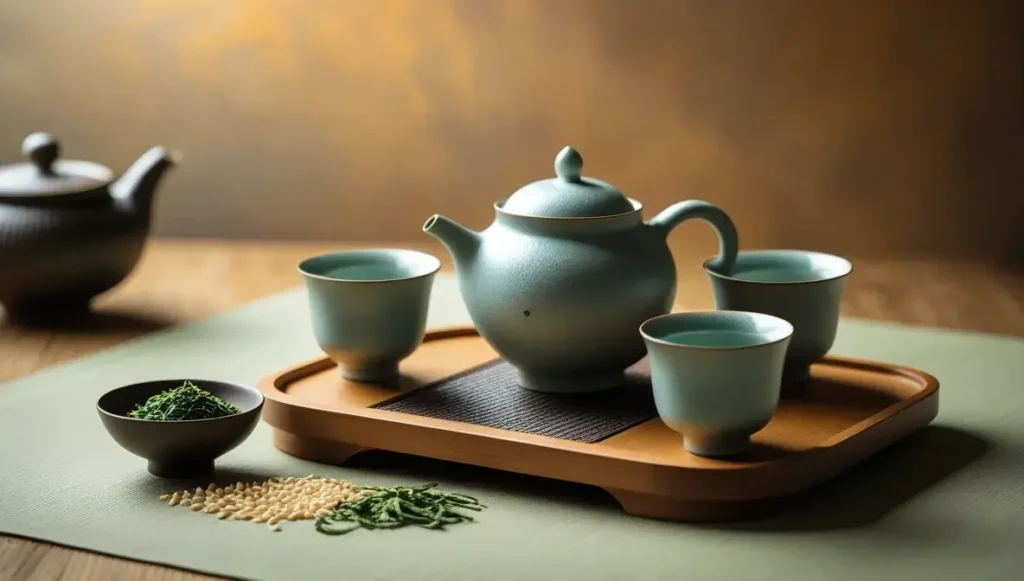
So, you’ve mastered the basics of brewing genmaicha, and now you’re ready to get a little more adventurous? That’s awesome! The beauty of this tea is its versatility. It’s not just about following a recipe; it’s about making it your own. Let’s talk about how you can play around with different elements to find your perfect cup.
Adjusting Leaf-to-Rice Ratios
This is probably the easiest way to tweak your genmaicha. The standard ratio can vary, but a good starting point is often around 1 part green tea leaves to 2 parts roasted brown rice. However, what if you want a stronger tea flavor? Use more leaves. Want it milder and nuttier, with more of that comforting rice note? Add more rice. Don’t be afraid to experiment with these proportions. It’s how you discover what truly sings to your palate.
Here’s a little guide to help you think about it:
- More Tea Leaves: Stronger green tea flavor, potentially more astringency, less rice prominence.
- More Roasted Rice: Milder tea flavor, more pronounced nutty and popcorn notes, a softer overall taste.
- Equal Parts: A balanced cup where both the tea and rice notes are clearly present.
Exploring Variations Like Matcha Iri Genmaicha
Genmaicha isn’t just green tea and rice. Have you heard of Matcha Iri Genmaicha? This version has a bit of matcha powder mixed in. It gives the tea a vibrant green color and adds a layer of creamy richness and a deeper, more complex flavor. It’s a fantastic way to experience genmaicha if you enjoy the unique taste of matcha. It’s a different kind of brew, offering a more intense experience compared to the standard organic Genmaicha tea.
Creating Your Own Roasted Tea Blends
Why stop at just green tea and rice? You can get really creative here. Some people like to add a bit of Hojicha, which is a roasted Japanese green tea. This creates a blend that’s even more mellow and has a deeper, toastier aroma. Think about other roasted elements or even different types of green tea. The possibilities are pretty wide open when you start thinking about different roast green tea brewing tips and how they might interact with the rice. It’s all part of the fun of brewing japanese green tea with rice and finding your signature style. These kinds of genmaicha preparation tips are really about personalizing your tea journey.
When you’re experimenting, remember that the quality of your base ingredients matters. Fresh tea leaves and well-roasted rice will always give you a better starting point, no matter what ratios or additions you decide to try. It makes a difference!
The Final Step in Your Genmaicha Tea How to Brew Journey.
So there you have it! Brewing genmaicha at home isn’t some big mystery. With just a few simple steps, you can whip up a cup that’s both comforting and flavorful. Whether you like it piping hot or a bit cooler to bring out the green tea’s sweetness, you’ve got the tools to make it just right. Don’t be afraid to play around with the tea-to-rice ratio or try different green teas as a base. Making your own genmaicha is a pretty neat way to enjoy a delicious, affordable tea that feels special. Cheers to your next perfect brew!
👉 Experience the Powerful Aroma of Authentic Genmaicha Tea 👈
Frequently Asked Questions
What exactly is Genmaicha tea?
Genmaicha is a Japanese green tea that’s made by mixing green tea leaves with roasted brown rice. Think of it as a cozy blend where the fresh taste of green tea meets the warm, nutty flavor of toasted rice. It’s sometimes called ‘popcorn tea’ because the rice can puff up a bit when roasted, looking like popcorn!
What does Genmaicha taste like?
Genmaicha has a really unique flavor! You’ll taste the fresh, sometimes grassy notes from the green tea, balanced by a comforting, toasty, and nutty flavor from the roasted brown rice. It’s not too strong and has a very pleasant, warming feel.
How do I brew Genmaicha for the best flavor?
For a regular Genmaicha, use boiling water (around 200-212°F or 93-100°C) and steep for about 30 seconds. If you have a higher quality Genmaicha, use slightly cooler water (around 175-185°F or 80-85°C) and steep for about 60 seconds to bring out its sweeter notes.
Can I make my own Genmaicha at home?
Yes, you absolutely can! It’s a fun process. You’ll need good quality green tea leaves (like Sencha) and some short or medium brown rice. You’ll roast the rice until it’s golden brown, let it cool, and then mix it with your tea leaves. You can experiment with how much rice and tea you use to find your perfect taste!
Is Genmaicha good for you?
Genmaicha is considered a healthy tea. Green tea itself is known for its antioxidants, and the roasted brown rice adds a comforting element. It’s a great way to stay hydrated and enjoy a warm, flavorful drink that’s generally lower in caffeine than coffee.
What’s the difference between normal and high-grade Genmaicha brewing?
The main difference is the water temperature and steeping time. For normal grade Genmaicha, you use hotter water (boiling) and a shorter steep (30 seconds) to really bring out the rice’s aroma. For high-grade Genmaicha, you use cooler water (around 80°C or 175°F) and a longer steep (60 seconds) to get the best flavor from the delicate green tea leaves.
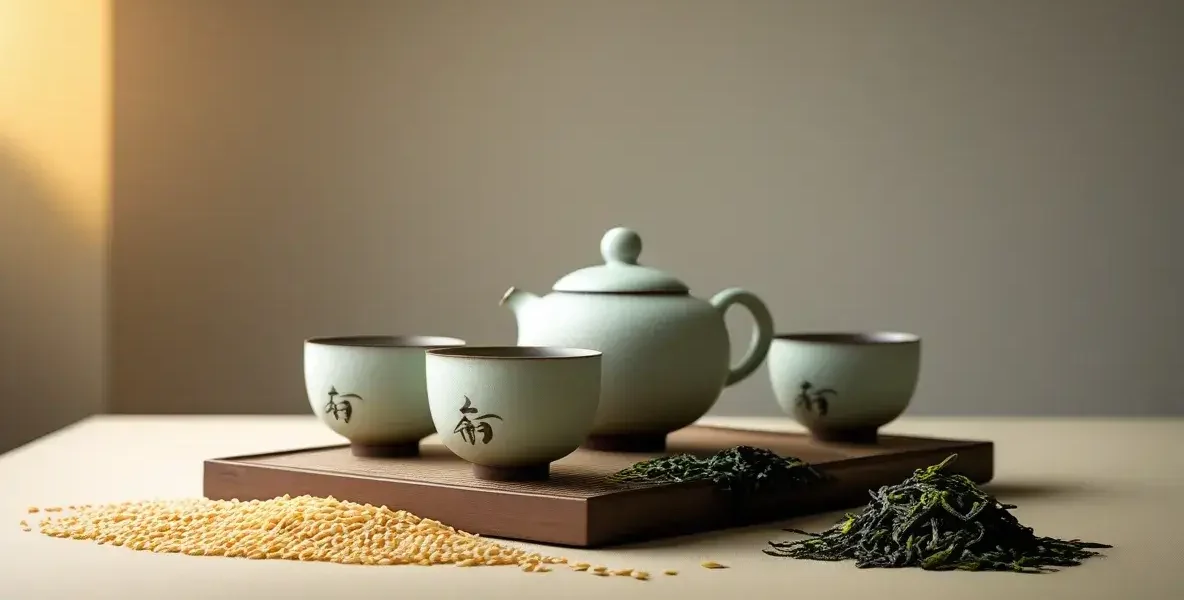






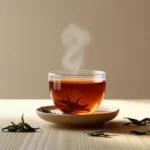
![Jasmine Tea vs Green Tea Benefits: Which Gives Better Health Results? [2025] jasmine tea vs green tea benefits](https://www.goteaworld.com/wp-content/uploads/2025/09/jasmine-tea-vs-green-tea-benefits-150x150.webp)




